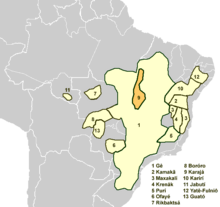Karajá language
| Karajá | |
|---|---|
| Native to | Brazil |
| Region | Araguaia River |
| Ethnicity | 3,600 Karajá people (2007) |
|
Native speakers
|
2,700 (2006) |
|
Macro-Gê
|
|
| Dialects |
|
| Language codes | |
| ISO 639-3 | |
| Glottolog | kara1500 |
 |
|
Karajá, also known as Ynã, is spoken by the Karajá people in some thirty villages in central Brazil. Dialects are North Karaja, South Karaja, Xambioá, and Javaé. There are distinct male and female forms of speech; one of the principal differences is that men drop the sound /k/, which is pronounced by women.
Karaja is a verb-final language, with simple noun and more complex verbal morphology that includes noun incorporation. Verbs inflect for direction as well as person, mood, object, and voice.
Karajá has eleven oral vowels, /I, i e ɛ, ɨ ə a, ʊ ,u o ɔ/, and four nasal vowels, /ĩ ə̃ ã õ/. /a/ is nasalized word initially and when preceded by /h/ or a voiced stop: /aθi/ → [ãθi] 'grass', /ɔha/ → [ɔhã] 'armadillo'; this in turn nasalizes a preceding /b/ or /d/: /bahadu/ → [mãhãdu] 'group', /dadi/ → [nãdi] 'my mother'.
This language has vowel harmony that matches vowels' tenseness to the vowel of the following suffix.
...
Wikipedia
